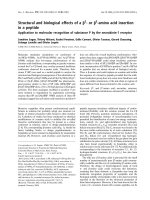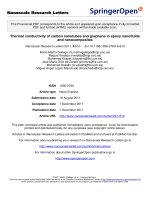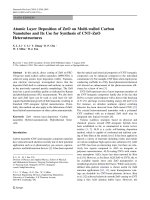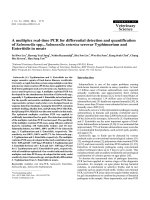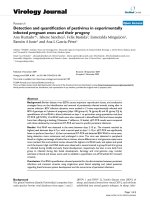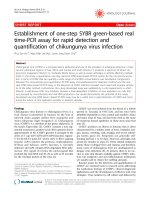Carbon nanotubes and branched DNA based nucleic acid assays towards a PCR free detection and quantification of nucleic acids
Bạn đang xem bản rút gọn của tài liệu. Xem và tải ngay bản đầy đủ của tài liệu tại đây (1.83 MB, 226 trang )
CARBON NANOTUBES AND BRANCHED-DNA BASED
NUCLEIC ACIDS ASSAYS:
TOWARDS A PCR-FREE DETECTION AND
QUANTIFICATION OF NUCLEIC ACIDS
LEE AI CHENG
(M.Sc., NTU, Singapore)
A THESIS SUBMITTED
FOR THE DEGREE OF DOCTOR OF PHILOSOPHY
DEPARTMENT OF BIOLOGICAL SCIENCES
NATIONAL UNIVERSITY OF SINGAPORE
2009
i
ACKNOWLEDGEMENTS
I would like to extend my sincere gratitude to all those who made this thesis possible.
Special thanks go to my supervisor A/P Lim Tit Meng (Dept. of Biol. Sci, NUS) and
co-supervisors A/P Heng Chew Kiat (Dept. of Paed., NUS) and A/P Tan Swee Ngin
(Nat. Sci. & Sci. Edu., NTU) who offered their expert guidances, invaluable counsel
and constant encouragements.
The scope of this research is multidisciplinary; many have contributed their
insights, their expertise and their precious time to help me. Thanks to A/P Allen Yeoh
(Dept. of Paed., NUH & NUS) and Ms. Chen Siew Peng for providing invaluable
information on leukaemia disease. Thanks to Dr. Ye Jian-Shan (NUS) for the many
fruitful discussions on carbon nanotubes and biosensors. I want to thank A/P Sheu
Fwu-Shan (NUS) and A/P Poenar D. Puiu (NTU) for their guidances. Special thanks
to Dr. Eishi Igata (NTU) for sharing his insights and experiences as a "veteran
researcher".
The support of my collaborators has allowed me to obtain excellent results for
publications. Special thanks to Dr. Lin Yuehe for the opportunities to collaborate with
his team (Dr. Chen Baowei, Dr. Liu Guodong, Dr. Wangjun, and Ms. Wu Hong) at
Pacific Northwest National Laboratory (PNNL). I would like to thank Dr. Zhang
Aiguo (Panomics, Inc) for the collaboration on using bDNA technology. I am grateful
to Dr. Dai Ziyu (PNNL) for his technical helps on preparing the p185-ssDNA
standard for quantitative assay and real-time PCR studies. Thanks to Prof. John Wang
(Dept. of Mat. Sci., NUS) and Ms. Agnes Lim Mui Keow for their assistances during
the AFM studies. I would like to acknowledge Ms. Karen Lee Siang Ling and Mr.
Yan Tie for their dedicated supports in our research laboratories. I would like to thank
my fellow colleagues who have helped me in this project in one way or another.
ii
The works described in this thesis were partially performed at the
Environmental Molecular Sciences Laboratory, a national scientific user facility
sponsored by the U.S. Department of Energy's (DOE's) Office of Biological and
Environmental Research and the core R&D Laboratory of Fungal Biotechnology
funded by the DOE Biomass Program, which are located at PNNL, USA. I gratefully
acknowledge the awards of NUS Postgraduate Research Scholarship and PNNL
Fellowship as well as the financial supports from A*STAR, Singapore (Grant No. 022
107 0008, project 'BioMEMS for Cell Characterization').
Lastly, I am grateful to my husband, parents and other family members for
their encouragements and patience throughout my research.
iii
TABLE OF CONTENTS
ACKNOWLEDGEMENTS i
TABLE OF CONTENTS iii
SUMMARY vii
LIST OF PUBLICATIONS xi
LIST OF TABLES xii
LIST OF FIGURES xiii
LIST OF ABBREVIATIONS xvii
CHAPTER 1 LITERATURE REVIEW 1
1.1 Hybridization and Detection of Nucleic Acids 1
1.1.1 Basic of nucleic acid hybridization 1
1.1.2 Label-free detection of nucleic acids 2
1.1.2.1 Electrochemical 3
1.1.2.2 Optical 9
1.1.2.3 Piezoelectric 10
1.1.3 Label-based detection of nucleic acids 11
1.1.3.1 Redox-active molecules 11
1.1.3.2 Enzymes 15
1.1.3.3 Nanoparticles 19
1.1.3.4 Multiple labelling for signal amplification 27
1.2 Carbon Nanotubes (CNTs) 27
1.2.1 Introduction 27
1.2.2 Structural and physical properties of CNTs 28
1.2.3 Functionalization of CNTs 29
1.2.3.1 Covalent 29
1.2.3.2 Non-covalent 32
1.2.4 Biological applications of CNTs 34
1.2.4.1 Delivery vectors 35
1.2.4.2 CNTs-based chemical and biosensors 37
1.3 Leukemia Models 44
1.3.1 Types of leukemia and classification 44
1.3.2 Conventional methods for the diagnosis of leukemia 45
1.3.3 The Philadelphia (Ph) chromosome and BCR-ABL variants 49
1.3.3.1 BCR-ABL variants 49
1.3.4 Detection of Ph chromosome and BCR-ABL oncogenes 52
1.4 Aims of the Study 54
1.5 References 56
iv
CHAPTER 2 CARBON NANOTUBE-BASED LABELS FOR HIGHLY
SENSITIVE COLORIMETRIC AND AGGREGATION-BASED VISUAL
DETECTION OF NUCLEIC ACIDS 74
2.1 Introduction 74
2.2 Materials and Methods 77
2.2.1 Reagents 77
2.2.2 Preparation of conventional and CNT-based labels 79
2.2.3 Atomic force microscope (AFM) characterization and sample preparation
79
2.2.4 Sandwich hybridization 80
2.2.4.1 Immobilization of capture probes to streptavidin-coated beads (SA-
beads) 80
2.2.4.2 Immobilization of capture probes to carboxylic acid functionalized
beads (COOH-beads) 80
2.2.4.3 Determination of CP density on SA-beads and COOH-beads 81
2.2.4.4 Hybridization with TG and NTG 81
2.2.4.5 Hybridization with conventional and CNT-based labels 82
2.2.5 Colorimetric detection 82
2.3 Results and Discussion 83
2.3.1 Synthesis and AFM characterization of the CNT-based labels 83
2.3.2 Detection and signal amplification principles 86
2.3.3 Specificity of bead conjugates on target detection using CNT-based labels
90
2.3.3.1 Types of bead 90
2.3.3.2 Blocking of bead surfaces 92
2.3.4 Analytical performance of CNT-based labels 95
2.3.5 Target-specific aggregation of CNT labels and beads 97
2.4 Conclusions 101
2.5 References 102
CHAPTER 3 SENSITIVE ELECTROCHEMICAL DETECTION OF
HORSERADISH PEROXIDASE AT a DISPOSABLE SCREEN-PRINTED
CARBON ELECTRODE 106
3.1 Introduction 106
3.2 Materials and Methods 109
3.2.1 Reagents 109
3.2.2 Voltammetric and amperometric measurements 109
3.3 Results and Discussion 111
3.3.1 Cyclic voltammetric characteristics of HRP-oAP–H
2
O
2
at the SPCE 111
3.3.2 Comparison of voltammetric and amperometric detection of the enzymatic
product 113
3.3.3 Factors affecting SWV analysis of HRP-o-AP-H
2
O
2
enzyme-substrate
system 116
3.3.3.1 Initial scanning potential 116
3.3.3.2 Working concentration of o-AP 118
3.3.4 Analytical characteristics of SWV detection of HRP 119
3.4 Conclusions 121
3.5 References 122
v
CHAPTER 4 PREPARATION OF SINGLE-STRAND DNA STANDARD FOR
THE QUANTITATIVE ASSAYS OF P185 BCR-ABL ONCOGENE 125
4.1 Introduction 125
4.2 Materials and Methods 127
4.2.1 Reagents 127
4.2.2 Cell cultures 129
4.2.3 mRNA extraction 129
4.2.4 RNA handling 130
4.2.5 Absorbance measurements 130
4.2.6 Synthesis of full-length p185 BCR-ABL single-strand DNA (p185-ssDNA)
131
4.2.6.1 Synthesis of the biotinylated double-strand DNA (dsDNA) 131
4.2.6.2 Purification of biotinylated dsDNA and gel electrophoresis 132
4.2.6.3 Purification of sense p185-ssDNA 133
4.2.7 Real-time quantitative PCR (RQ-PCR) 134
4.3 Results and Discussion 137
4.3.1 Principle of the preparation of p185-ssDNA standard 137
4.3.2 Gel electrophoresis 140
4.3.3 Quantification of mRNA 141
4.3.4 Quantification of p85-ssDNA standard 143
4.3.5 Functionality of p185-ssDNA 144
4.4 Conclusions 146
4.5 References 147
CHAPTER 5 ELECTROCHEMICAL DETECTION OF LEUKEMIA
ONCOGENES AT ATTOMOLES LEVELS WITH A CARBON NANOTUBES-
BASED LABEL 149
5.1 Introduction 149
5.2 Materials and Methods 153
5.2.1 Reagents 153
5.2.2 Preparation of CNT-based labels 154
5.2.3 UV-vis absorption spectroscopy 155
5.2.4 Cell cultures and mRNA extraction 155
5.2.5 Synthesis of full-length p185-ssDNA 156
5.2.6 Sandwich hybridization 156
5.2.6.1 Immobilization of CP-2 to COOH-beads 156
5.2.6.2 Targets hybridization 157
5.2.6.3 Hybridization with CNT-based labels 157
5.2.7 Samples assay 157
5.2.7.1 HRP enzymatic reaction 157
5.2.7.2 Electrochemical detection 158
5.3 Results and Discussion 159
5.3.1 Characteristics of the CNT-based labels 159
5.3.2 Electrochemical detection and signal amplification principles 160
5.3.3 Composition of CNT-based Labels 162
5.3.3.1 Effect of DP loading 162
5.3.3.2 Effect of HRP loading 164
5.3.4 Amount of CNT-based labels 166
5.3.5 SWV detection of leukemic oligonucleotide targets amplified with CNT-
based labels 167
vi
5.3.6 Discrimination of non-complementary and mismatched sequences 170
5.3.7 Detection of p185-ssDNA targets 172
5.3.8 Detection of p185 BCR-ABL mRNA fusion transcript extracted from cell
line 173
5.4 Conclusions 175
5.5 References 176
CHAPTER 6 ELECTROCHEMICAL BRANCHED-DNA ASSAY FOR PCR-FREE
DETECTION AND QUANTIFICATION OF ONCOGENES IN MESSENGER RNA
179
6.1 Introduction 179
6.2 Materials and Methods 182
6.2.1 Reagents 182
6.2.2 Electrochemical measurements for ALP enzymes 183
6.2.3 Cell cultures and mRNA extraction 184
6.2.4 Preparation of sense p185-ssDNA 184
6.2.5 bDNA hybridization assay 184
6.3 Results and Discussion 185
6.3.1 Detection and signal amplification principles 185
6.3.2 Electrochemical Measurements of ALP on the SPCE 187
6.3.3 bDNA hybridization assay of p185-ssDNA standards 190
6.3.4 Detection of p185 BCR-ABL mRNA fusion transcript extracted from cell
line 192
6.3.5 Quantitative mRNA assay: electrochemical bDNA assay vs. fluorescent
RQ-PCR 195
6.4 Conclusions 197
6.5 References 198
CHAPTER 7 CONCLUDING REMARKS AND FUTURE WORKS 200
vii
SUMMARY
The research effort is directed towards the development of polymerase chain reaction
(PCR)-free ultrasensitive nucleic acids detection based on signal amplification
approach. Electrochemical and optical nucleic acids assays based on (I) a novel
carbon nanotube (CNT)-based label, (II) a branched DNA (bDNA) amplifier have
been developed for the significant amplification of nucleic acids hybridization signal,
which in turn improves the assay sensitivity, and (III) a single-strand DNA (ssDNA)
standard bearing the same sequence and length as of the target gene was created and
accurately quantified for use in the PCR-free quantitative assays. These assays have
been successfully validated for PCR-free detection and quantification of p185 BCR-
ABL fusion transcript in the messenger RNA (mRNA) population extracted from
human acute lymphocytic (ALL) leukemia cell line SUP-B15.
The details of various sections are as follows:
(I) CNT-based label
A novel multiple enzymes conjugated CNT-based label has been developed for highly
sensitive optical and electrochemical detection of human ALL related p185 BCR-ABL
fusion transcript. The carboxylated CNTs were functionalized with horseradish
peroxidase (HRP) tracers and DNA detection probes (DP) via diimide-activated
amidation. The constructs were used as label for a magnetic bead-based DNA
hybridization assay. The labels were attached to the magnetic beads surface via
specific hybridization of DNA detection probes to the captured targets. The amount of
targets was quantified by measuring the activity of captured HRP.
viii
The hybridization assay amplified by CNT-based label was first demonstrated
via colorimetric measurements by measuring the absorbance of product. The resulting
CNT labels significantly enhanced the nucleic acids assay sensitivity by at least 1000
times compared to that of conventional labels used in enzyme-linked oligosorbent
assay (ELOSA). An excellent detection limit of 1 × 10
-12
M (60 × 10
-18
mol in 60 μL)
and a 4-order wide dynamic range of target concentration were achieved. Such
approach makes the sensitivity of conventional colorimetric ELOSA of DNA
comparable to that of fluorescent and luminescent techniques. Hybridizations using
these labels were coupled to a concentration-dependent formation of visible dark
aggregates. Targets can thus be detected simply with visual inspection, eliminating
the need for expensive and sophisticated detection systems.
A rapid and simple electrochemical assay of HRP performed on disposable
screen-printed carbon electrode was developed. HRP activities were monitored by
SWV measuring the electroactive enzymatic product in the presence of o-
aminophenol and hydrogen peroxide substrate solution. The voltammetric
characteristics of substrate and enzymatic product as well as the parameters of SWV
analysis were optimized. With optimized conditions, a linear response for HRP from
0.003 - 0.1 U mL
-1
and a detection limit of 1.25 × 10
-15
mol (in 25 µL) were obtained
with a good precision (relative standard deviation = 8 %; n = 6). The resulting HRP
assay was coupled to the nucleic acids assay amplified by the CNT-based labels. The
effect of DP and HRP loading of the labels on the signal-to-noise ratio of
electrochemical detection was studied systematically. With optimized conditions, the
signal-amplified assay achieved a detection limit of 83 × 10
-15
M (5 × 10
-18
mol in 60
µL) targets oligonuecleotides and a 4-order wide dynamic range of target
concentration. The resulting assay allowed a robust discrimination between the
ix
perfect match and a three-base mismatch sequence. When subjected to full-length
oncogene (491 bp), the approach demonstrated a detection limit of 1 × 10
-16
mol in 60
μL which corresponded to approximately 33 pg of the target gene. The high
sensitivity and specificity of assay enabled PCR-free detection of target transcripts in
approximately 65 ng of mRNA extracted from positive ALL cell lines SUP-B15, in
comparison to those obtained from negative cell lines HL-60. The approach holds
promise for simple, low cost and ultrasensitive electrochemical nucleic acids
detection in portable devices, POC and early disease diagnostic applications.
(II) bDNA-amplified electrochemical nucleic acids assay
A novel electrochemical bDNA assay has been developed for PCR-free detection and
quantification of p185 BCR-ABL leukemia fusion transcript in the population of
mRNA extracted from cell lines. The bDNA amplifier carrying high loading of
alkaline phosphatase (ALP) tracers was used to amplify targets signal. The targets
were captured on microplate well surfaces through cooperative sandwich
hybridization prior to the labeling of bDNA. The activity of captured ALP was
monitored by SWV analysis of the electroactive enzymatic product in the presence of
1-napthyl-phosphate. The voltammetric characteristics of substrate and enzymatic
product as well as the parameters of SWV analysis were systematically optimized. A
detection limit of 1 × 10
-15
M (1 × 10
-19
mol in 100 μL) of full-length oncogene and a
3-order wide dynamic range of concentration were achieved. Such limit corresponded
to approximately 17 fg of the p185 BCR-ABL. The specificity and sensitivity of assay
enabled direct detection of target transcript in as little as 4.6 nanograms mRNA
without PCR amplification. In combination with the use of a well-quantified standard
(III), the electrochemical bDNA assay was capable of direct use for a quantitative
x
analysis of target transcript in total mRNA population. The assay could detect 62900
copies of p185 BCR-ABL in one nanogram mRNA population, which was at least 50-
fold higher than that of real-time quantitative PCR (RQ-PCR). The finding was
consistent with the underestimation of targets by RQ-PCR reported earlier. The
approach thus provides a simple, sensitive and quantitative tool alternate to the RQ-
PCR for early disease diagnosis.
(III) Preparation of ssDNA standard for quantitative assays
A ssDNA standard bearing the same sequence and length as of the target, i.e. p185
BCR-ABL (denotes p185-ssDNA) was created. First, biotinylated reverse primer was
used for full-length reverse transcription (RT)-PCR of p185 BCR-ABL to produce
biotinylated double-strand PCR amplicons. The resulting amplicons were purified by
gel electrophoresis followed by agarose digestion, phenol-chloroform extraction and
ultrafiltration. The purified biotin-amplicons were immobilized on the streptavidin-
coated magnetic beads. The non-biotinylated sense-strand was separated from the
undesirable bead-bound antisense-strands by elution with Tris-HCl buffer at 95
o
C for
5 min. The eluate containing pure sense strands p185-ssDNA was collected. The
purified p185-ssDNA was quantified by UV absorbance at 260 nm and bench-marked
by the RQ-PCR. Successful detection of the p185-ssDNA by both CNT-based label
and bDNA hybridization assays indicated good integrity and functionality of the
standard. The approach offers a means to prepare standard suitable for non-PCR
based quantitative nucleic acid assays.
xi
LIST OF PUBLICATIONS
Journal papers:
1. Lee AC
, Dai Z, Chen B, Wu H, Wang J, Zhang A, Zhang L, Lim TM, Lin Y.
Electrochemical branched-DNA assay for polymerase chain reaction-free detection
and quantification of oncogenes in messenger RNA. Anal. Chem. 2008;80:9402-9410.
2. Lee AC,
Liu G, Heng CK, Tan SN, Lim TM, Lin Y. Sensitive electrochemical
detection of horseradish peroxidase at disposable screen-printed carbon electrode.
Electroanal. 2008;20:2040-2046.
3. Lee AC
, Ye JS, Tan SN, Poenar DP, Sheu FS, Heng CK, Lim TM. Carbon
nanotube-based labels for highly sensitive colorimetric and aggregation-based visual
detection of nucleic acids. Nanotechnology 2007;18:455102. [featured in Small
2007;3:1836-1837]
4. Lee AC, Ye JS, Tan SN, Poenar DP, Sheu FS, Heng CK, Lim TM, Carbon
nanotube-based labels for sensitive nucleic acids detection. Nanotech. 2006; 2: 232-
235.
5. Lee AC
, Chen B, Liu G, Heng CK, Tan SN, Lim TM, Lin Y. Electrochemical
detection of leukemia oncogenes at attomole level using carbon-nanotubes-based
labels. Submitted to ACS Nano.
Patent:
1. “Bio-conjugate carbon nanotubes based labels” US Patent Application No.
11/510,308. Inventors: Lee Ai Cheng
, Lim Tit Meng, Ye Jian Shan and Heng Chew
Kiat.
Conference papers:
1. Lee AC, Liu G, Lin Y, Lim TM, Heng CK, Tan SN, Wang J, Wu H, Lin YY.
Highly sensitive electrochemical nucleic acids detection based on carbon nanotubes-
derived labels. 62
nd
Northwest Regional meeting (NORM 2007), 17-20 June 2007,
Boise, Idaho, USA.
2. Lee AC, Liu G, Lin Y, Heng CK, Tan SN, Wang J, Wu H, Lim TM, Lin Y. Highly
sensitive electrochemical nucleic acids biosensor based on carbon-nanotubes-derived
labels for leukemia diagnosis. Medicine-infectious Diseases Continuing Medical
Education Conference: What’s New in Medicine 2007, 8 & 9 June 2007, Kennewick,
WA, USA.
3. Lee AC, Ye JS, Tan SN, Poenar PD, Sheu FS, Heng CK, Lim TM. Carbon
nanotube-based labels for sensitive nucleic acids detection. 2006 NSTI Nanotechology
conference and Trade Show, 7-11 May 2006, Boston, MA, USA.
xii
LIST OF TABLES
Table 1.1 Techniques used for label-free detection of nucleic acids 3
Table 1.2 Redox-active labels used in electrochemical nucleic acid assays 12
Table 1.3 Enzyme labels used in electrochemical nucleic acid assays 16
Table 1.4 Nanoparticles labels used in electrochemical nucleic acid assays 26
Table 1.5 Methods for detecting phenotypic and genotypic features of leukemic cells
46
Table 2.1 Sequences of oligonucleotides used in hybridization assay 78
Table 2.2 Parameters of CP-bound COOH-beads and SA-beads used for each
hybridization reaction 91
Table 4.1 Sequences of primers used in general PCR, RT-PCR and RQ-PCR. 128
Table 4.2 Typical yields of mRNA extracted from individual batches of (A) SUP-B15
and (B) HL-60 cell cultures 142
Table 4.3 Typical concentration and purity of p185-ssDNA standard. 144
xiii
LIST OF FIGURES
Figure 1.1 Basic principle of nucleic acids hybridization and detection on a solid
surface 2
Figure 1.2 Direct electrochemistry DNA detection based on the oxidation of guanine
base 5
Figure 1.3 Labeling of nucleic acids with electroactive labels 13
Figure 1.4 An enzymatic amplification of DNA hybridization signal measured by EIS
method 19
Figure 1.5 Metal nanoparticle-based electrochemical detection of DNA 20
Figure 1.6 Detection of DNA based on conductivity measurement 25
Figure 1.7 Schematic representation of (A) a MWNT and (B) a SWNT 28
Figure 1.8 Surface groups bonded to aromatic rings on CNTs 30
Figure 1.9 Carboxylic acid derivatization of CNTs 31
Figure 1.10 Configuration of CNTs-modified electrochemical electrodes. (A)
randomly oriented CNTs, (B) vertically aligned CNTs array, (C) field effect transistor
(FET) 38
Figure 1.11 The translocation of BCR-ABL. The structures of BCR and ABL are
shown in (A) and (B), respectively. Boxes denote exons and lines refer to introns. (C)
Depending on the location of breakpoints (arrows) in BCR, the translocation results in
the formation of three variants of the BCR-ABL gene, i.e. p185, p210 and p230 53
Figure 2.1 Diimide-activated amidation for conjugation of SWNT–HRP–DP.
Horseradish peroxidase (HRP) enzyme-labeled detection probes (DPs) were
covalently conjugated to the carboxylated SWNTs in the presence of the cross-linker
N-(3-dimethylaminopropyl)-N’ -ethylcarbodiimide hydrochloride (EDC) 83
Figure 2.2 Height images from the AFM analysis of (A) a bare SWNT (average
height = 1.0 nm), (B) a SWNT-HRP-DP conjugate (a, b, c, d = 1.3, 0.8, 3.3 and 3.1
nm respectively), (C) the conventional HRP-DP labeling reaction mixture (e, f, g =
2.5, 4.3, 3.0 nm respectively) on mica substrate 85
Figure 2.3 Schematic representation of signal amplification for sandwich
hybridization assay performed on magnetic beads. The signal-to-single hybridization
event ratio of (A) the conventional HRP label is amplified by (B) multiple HRP and
DP-conjugated CNT-based labels 87
Figure 2.4 Concentration of CPs in solution collected during CP-SA-beads
immobilization reaction analyzed by NanoDrop ND-1000 spectrophotometer. 88
xiv
Figure 2.5 Concentration of CPs in solution collected during CP-COOH-beads
immobilization reaction analyzed by NanoDrop ND-1000 spectrophotometer. 89
Figure 2.6 Carboxylic acid functionalized beads (COOH-beads) and streptavidin-
coated beads (SA-beads) for the hybridization of 1 × 10
−8
M of target (gray bars) and
negative control samples (white bars) using CNT-based labels. 91
Figure 2.7 Effect of blocking in the hybridization of 1 × 10
−8
M of target (gray bars)
and negative control samples (white bars) using CNT-based labels 93
Figure 2.8 The effects of specificity of bead conjugates on the performance of TG
detection using CNT-based labels. (A) SA-beads. (B) COOH-beads 94
Figure 2.9 Analytical performance of CNT-based labels. (A) responses to TG
samples of the hybridization assay performed on COOH-beads with 8 % blocking.
The bars for control, 1E-12M and 1E-11M of TG in (A), have been enlarged in the
inset at the upper left. (B) the corresponding log–log graph of the dynamic detection
range plotted with values after control subtraction 96
Figure 2.10 The appearance of magnetic beads (SA-beads) in wash buffer solution
after hybridization in the assay using CNT-based labels 100
Figure 3.1 (A) Electro-oxidation of o-AP in acidic solution produces 3-
aminophenoxazone (3-APZ) as the major product. (B) The redox reaction of 3-APZ.
108
Figure 3.2 Cyclic voltammograms of o-AP in the absence and presence of HRP using
the SPCE in a pH5.7 BR buffer solution containing 0.04 M each of H
3
PO
4
, HOAc and
H
3
BO
3
: (a) 1.2 ×
10
-5
M o-AP + 2 × 10
-4
M H
2
O
2
; (b) as in (a) + 0.25 U mL
-1
HRP
112
Figure 3.3 Responses at the SPCE to o-AP enzymatic product catalyzed by HRP in
BR buffer recorded using (a) SWV, (b) DPV and (c) amperometric techniques 115
Figure 3.4 Effect of initial scanning potential on SWV responses of enzymatic
product (grey bars) and blank substrate (white bars) solution 117
Figure 3.5 Optimization of substrate concentration 119
Figure 3.6 Typical SWV responses of increasing HRP concentration in PBS buffer.
From bottom to top, the concentration of HRP in PBS buffer is 0.1, 0.05, 0.025,
0.012, 0.006, 0.003 and 0 U mL
-1
, respectively. Insert shows the calibration curve of
HRP 120
Figure 4.1 (A) pGEM
®
-T Vector circle map. Multiple cloning site (MCS) is located
at 10 to 113. This vector has been linearized with EcoR V at base 51 from that of the
circular pGEM
®
-5Zf(+) vector and a T is added to both 3´-ends. The p185 BCR-ABL
gene is inserted between the base 51 and 52 (cloned insert as in B). (B) The promoter
and MCS sequence of the pGEM
®
-T Vector 136
xv
Figure 4.2 Schematic representation of the synthesis of biotinylated p185 dsDNA
from p185 BCR-ABL mRNA template 138
Figure 4.3 Schematic representation of the purification of sense p185-ssDNA from
biotinylated p185 dsDNA 139
Figure 4.4 Agarose gel electrophoretic image of the double-stranded (Lane 2) and
single-stranded DNA (Lane 3) for the p185 BCR-ABL gene 140
Figure 4.5 Validation of p185-ssDNA standards based on electrochemical
hybridization assays amplified by (A) CNT-based labels and (B) bDNA amplifiers
145
Figure 5.1 Visible absorption spectra of (a) horseradish-peroxidase enzymes (HRPs),
(b) single-stranded DNA detection probes (DPs), (c) SWNT-DP-HRP conjugates and
(d) single-walled carbon nanotubes (SWNTs) in ultrapure water. 160
Figure 5.2 Schematic representation of signal-amplified electrochemical detection of
nucleic acid targets based on CNT-based labels. (A) Sandwich hybridization assay
performed on magnetic beads. (B) The targets were quantified by measuring the
electroactive enzymatic product, formed by the HRP catalyzed reaction with o-AP-
H
2
O
2
substrate solution using a screen-printed electrode. (C) The resulting SWV
voltammogram indicates a well-defined reduction peak for TG/p185-ssDNA/mRNA
targets 161
Figure 5.3 Influence of the composition of CNT-based labels on TG detection. (A)
The effect of DP loading per gram of CNT added to the label synthesis mixture. (B)
The effect of HRP loading. 165
Figure 5.4 Optimal amount of CNT-based labels required for each hybridization
reaction. The labels were synthesized at optimum reaction composition of 2.5 µmol/g
of CNT and 35 % v/v HRP 167
Figure 5.5 Calibration curves for the electrochemical quantitation of leukemic DNA
target amplified by the CNT-based labels. The dynamic detection range constitutes
(A) the high-range linear plot (left) and the corresponding square-wave
voltammograms (right), and (B) the enlarged low-range linear (left) and the
corresponding voltammograms (right) 169
Figure 5.6 Specificity of the electrochemical detection of leukemic DNA targets
amplified by CNT-based labels. (A) Discrimination between complementary target
(TG) and non-complementary target (NTG). (B) Discrimination between TG and
mismatched sequences 171
Figure 5.7 Typical SWV responses with increasing amounts of p185-ssDNA From
top to bottom, the amounts of target is 0, 4.8 × 10
-16
, 1.4 × 10
-15
, 2.9 × 10
-15
, 5.7 × 10
-
15
and 1.2 × 10
-14
mol, respectively. Inset shows the resulting calibration plot 173
xvi
Figure 5.8 Direct electrochemical measurement of p185 BCR-ABL mRNA fusion
transcript extracted from the positive leukemia cell line SUP-B15 and negative cell
line HL-60 174
Figure 6.1 Schematic illustration of the branched DNA (bDNA)-amplified
electrochemical detection and quantitation of human leukemia BCR-ABL mRNA
fusion transcript 187
Figure 6.2 (A) CV and (B) SWV voltammograms of 1-napthyl-phosphate substrate
solution in the absence (curves a) and presence (curves b) of ALP using the SPE. (C)
Optimization of substrate concentration ranged from 0.01 to 5 mM. (D) The linear-
plot of SWV detection of ALP 189
Figure 6.3 (A) Typical SWV responses with increasing standard concentrations. (B)
The resulting calibration plot with the lower left portion being enlarged as in (C) 191
Figure 6.4 (A) Direct electrochemical measurement of p185 BCR-ABL mRNA fusion
transcript. The mRNA samples were extracted from the positive leukemia cell line
SUP-B15 and negative cell line HL-60. (B) The corresponding linear response and
null response of SWV to the mRNA samples extracted positive and negative cell
lines, respectively 194
Figure 6.5 Chemiluminescent measurement of the p185 BCR-ABL mRNA fusion
transcript 195
Figure 6.6 Electrochemical bDNA assay for quantification of target genes in the
mRNA samples. The unknown quantities of the target genes on three different
amounts of mRNA sample (pink) were determined using a set of 5-points p185-
ssDNA standards (blue). 196
xvii
LIST OF ABBREVIATIONS
3-APZ 3-aminophenoxazone
ABL Abelson leukemia
ABTS 2’azino-bis-(3-ethylbenzothiazoline-6-sulfonic acid
AFM atomic force microscope
ALL acute lymphocytic leukemia
ALP alkaline phosphatase
AML acute myelogenous leukemia
ASV adsorption stripping voltammetry
ATCC american type culture collection
AU absorbance unit
bDNA branched DNA
BCR breakpoint cluster region
BL blocker primer
bpy bipyridine
BR britton-robinson
BRCA1 breast cancer 1 gene
BSA bovine serum albumin
BVRB biliverdin IXß reductase enzyme
cDNA complementary DNA
CE capture extender
CLL chronic lymphocytic leukemia
CML chronic myelogenous leukemia
CML-N neutrophilic-chronic myeloid leukemia
CNNFET CNTs network FET
xviii
CNT carbon nanotube
COOH-beads carboxylic acid functionalized beads
CP capture probe
CpG cytosine-phosphate-guanine
Ct cycle threshold
CSV cathodic stripping voltammetry
CV cyclic voltammetry
CVD chemical vapor deposition
DAB diaminobenzidine
DCC dicyclohexylcarbodiimide
DME dropping mercury electrode
DMF dimethylformamide
DNA deoxyribonucleic acid
dNTP Deoxyribonucleotide triphosphate
DP detection probe
DPV differential-pulsed voltammetry
dsDNA double-strand DNA
DTT dithiothreitol
ECL electrogenerated chemiluminescent
EDC ethylcarbodiimide hydrochloride
EDTA ethylenediamine tetraacetic
EIS electrochemical impedance spectroscopy
ELOSA enzyme-linked oligosorbent assay
FA folic acid
FAB French-American-British
xix
FBS fetal bovine serum
FISH fluorescence in situ hybridization
FND ferrocenyl naphthalene diimide
FET field effect transistor
FP forward primer
f-CNT functionalized CNT
GCE glassy carbon electrode
gDNA genomic DNA
GMA gold microelectrode array
GOD glucose oxidase
HCMV human cytomegalovirus
HER-2 human epidermal growth factor receptor 2
HMDE hanging mercury drop electrode
HOPGE highly oriented pyrolytic graphite electrode
HPV human papillomavirus
HRP horseradish peroxidase
IMDM Iscove’s modified dulbecco’s medium
ITO indium tin oxide
LbL layer-by-layer
LOC lab-on-chip
LSV linear-sweep voltammetry
M1 one-base mismatch
M3 three-base mismatch
MB methylene blue
M-bcr major breakpoint cluster
xx
m-bcr minor breakpoint cluster
MCS multiple cloning site
MES 2-(N-morpholino) ethanesulfonic acid
MIC morphologic immunologic cytogenetic
mRNA messenger RNA
MRD minimal residue disease
MWNT multi-walled nanotube
NaDDS sodium dodecylbenzenesulfonate
NADH nicotinamide adenine dinucleotide hydrogen (reduced)
NF-κB
nuclear factor-kappa B
NSA nonspecific adsorption
NTC no template control
NTG noncomplementary target
o-AP o-aminophenol
ODA octadecylamine
ODN oligodeoxynucleotides
OPD o-phenylenediamine dihyrochloride
Os,biby osmium textroxide with 2,2’-bipyridine
PBS phosphate buffer saline
PCR polymerase chain reaction
PEG poly(ethylene glycol)
PGE pyrolytic graphite electrode
Ph philadelphia chromosome
PIND-Os Os(2,2’-bipyridine)
2
Cl
+
pendants
PL phospholipid
xxi
PNA peptide nucleic acid
POC point-of-care
Poly-A polyadenine
PPE poly(aryleneethynylene)
PPEI-EI poly(propionylethylenimine-coethylenimine)
PPy polypyrrole
PSA potentiometric stripping analysis
PSN poly(styrene-co-aminomethylstyrene)
QCM quartz crystal microbalance
R
et
electron transfer resistance
RP reverse primer
RQ-PCR real-time quantitative PCR
RSD relative standard deviation
RT reverse transcription
RT-PCR reverse transcription-PCR
SA-beads streptavidin-coated beads
SAM self assembled monolayer
SBE single-base extension
SD standard deviation
SDS sodium dodecyl sulfate
SNP single nucleotide polymorphism
S/N signal-to-noise ratio
SPCE screen-printed carbon electrode
SPR surface plasmon resonance
ssDNA single-strand DNA
xxii
STM scanning tunnelling microscopy
SWNT single-walled nanotube
SWV square-wave voltammetric
TBE tris-borate-EDTA
TEM transmission electron microscope
TG complementary target
TMB 3,3’,5,5’-tetramethylbenzidine
TS Tay-Sachs
Tween-20 polyethylene glycol sorbitan monolaurate
UNG uracil N-glycosylase
-bcr micro-bcr
UV ultra violet
WHO World Health Organization
1
CHAPTER 1 LITERATURE REVIEW
1.1. Hybridization and Detection of Nucleic Acids
1.1.1. Basic of nucleic acid hybridization
The nucleic acid is a polymer consists of monomers called nucleotides. Each
nucleotide composes of a nitrogenous base, a pentose sugar and a phosphate group. In
deoxyribonucleic acid (DNA), the bases are the purine adenine (A) and guanine (G)
as well as the pyrimidines cytosine (C) and thymine (T). In deoxyribonucleic acid
(RNA), T is replaced by uracil (U). Nucleic acid hybridization relies on the Watson-
Crick base-pairing properties of DNA. The base pairing is specific in which G is
paired to C and A to T (A to U in RNA:DNA hybrids) by hydrogen bonding.
Most of the nucleic acid hybridization assays are performed on a solid surface.
These solid surfaces can be the membrane used in conventional Southern
1
and
Northern
2
blots (for the detection of DNA and RNA respectively), glass or silicon in
microarray,
3
electrode in electrochemical sensors
4 - 6
and microsphere beads.
7 - 9
The hybridization assays rely mainly on the specific hybridization of a
surface-bound single-stranded oligonuecleotides sequence (i.e. the capture probe) to
the complementary region of the target nucleic acid.
4
This molecular recognition
event triggers a usable signal, which can be measured by means of optical,
electrochemical or piezoelectric readout depending on the methods of signal
transduction (Figure 1.1). Among them, electrochemical nucleic acids biosensors have
gained considerable attention in recent years due to its low-cost and simplicity
suitable for the development of portable devices. Several comprehensive reviews on
electrochemical DNA biosensors have also been published.
4 - 6, 10
2
Figure 1.1 Basic principle of nucleic acids hybridization and detection on a solid
surface
The signal transduction strategies of nucleic acids hybridization can be
broadly divided into two main categories: label-free and label-based approaches.
Major considerations in the nucleic acids sensing are the detection limit and
specificity of the detection. An ideal approach should be capable of discriminating the
perfectly matched target nucleic acids from those with a single base-pair mismatch
without requiring amplification of the target samples. Unfortunately, in many cases,
each technique has their pros and cons.
The following sections aim to introduce the label-free (Section 1.1.2) and
label-based (Section 1.1.3) approaches and the efforts towards improving the
sensitivity and specificity of assays with an emphasis on the electrochemical nucleic
acids detection.
1.1.2. Label-free detection of nucleic acids
There are attempts to measure the hybridization signal directly in the absence of a
secondary reporting molecule, i.e. label. The common label-free techniques used to
transduce the hybridization signal to a measurable read-out are listed in Table 1.1.
These strategies generally achieve moderate sensitivity with the detection limit at the
Target
Capture
Probe
Solid
surface
hybridization
Signal
Signal Transduction
Optical
Electrochemical
Piezoelectric

